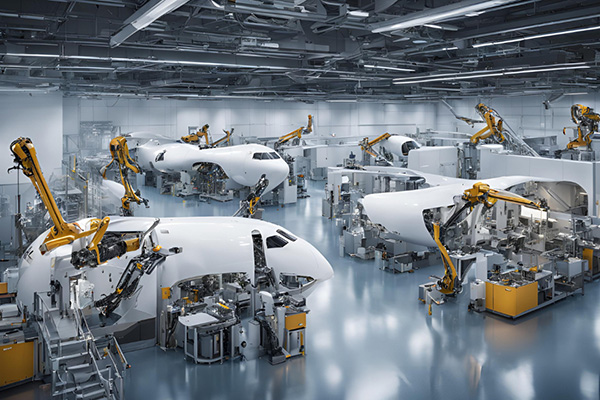ASI-powered robotics are cutting downtime and boosting efficiency with real-time adaptability, reshaping the future of manufacturing.
By: Matthew Brown, Founder and CEO, ThoughtForge AI & Mike Cardamone, CEO and Managing Partner, Forum Ventures
The physical world of manufacturing is unpredictable. Yet, most robotic AI systems today are trained to handle specific scenarios, relying on pre-defined datasets and rigid programming to function within known conditions. The problem? When faced with an unfamiliar anomaly—something outside its predefined dataset—the system stalls, often leading to costly disruptions.
This challenge is particularly acute in high-mix, low-volume (HMLV) manufacturing environments, where variability is the rule, not the exception. Traditional AI-powered robotics struggle to adapt in real-time, requiring extensive, constant retraining and intervention. This limitation—rooted in backpropagation-based learning—hampers productivity, increases operational costs, and contributes to unplanned downtime, which can cost manufacturers upwards of $260,000 per hour (self-correcting robotics are already helping address these issues).
For decades, the prevailing response to robotic limitations has been to collect more data and train models on increasingly vast datasets in hopes of improving adaptability. But the real path to autonomy isn’t about accumulating more information—it’s about enabling machines to learn dynamically, responding to real-world variability with human-like adaptability
Next-generation AI-driven robotics are moving beyond reactive automation to leveraging real-time, multimodal learning to make context-aware decisions. These systems don’t just react—they anticipate, adjust, and optimize in real time. Instead of requiring downtime for recalibration, they continuously refine their actions, ensuring precision even in unpredictable conditions. This paradigm shift—from static AI models to dynamic, adaptive intelligence—is enabling an economy-wide automation revolution.
While much of the AI conversation today revolves around Artificial General Intelligence (AGI)—systems designed to replicate human cognition—the real breakthroughs in robotics lie in Artificial Specific Intelligence (ASI). Rather than attempting to mimic broad human reasoning, ASI is designed to master specialized industrial skills with extreme precision and efficiency.
Unlike traditional AGI, which requires constant retraining to handle variations, ASI-powered systems excel in high-dexterity, high-variability environments. Whether handling delicate wiring, conducting high-precision inspections, or executing intricate assembly processes, ASI enables robots to make sub-millisecond decisions based on live sensory feedback, while learning from every interaction. This means robots are no longer just executing commands; they are engaging in real-time problem-solving, making manufacturing processes more resilient and efficient at scale. Dynamic AI in robotics is the linchpin that bridges isolated efficiency with broad, transformative industrial scalability.

Industries that rely on precision and adaptability, such as aerospace and energy, are already witnessing the benefits of ASI-powered robotics. In aerospace manufacturing, for example, complex assembly tasks often involve confined spaces and delicate materials, requiring a level of dexterity beyond traditional automation. ASI-powered systems navigate these challenges with ease, making split-second adjustments based on sensory feedback, continuously optimizing their movements to ensure accuracy without the need for constant human intervention.
Similarly, in the energy sector, maintenance and inspection tasks often occur in hazardous environments. ASI-powered robotics can perform these high-risk operations with greater accuracy, reducing human exposure to dangerous conditions while ensuring uninterrupted operations. This capability is a game-changer in predictive maintenance, where AI-driven automation can proactively identify and mitigate potential failures before they lead to costly downtime.
Manufacturing is evolving beyond efficiency to resilience and adaptability. ASI-powered robotics is creating a living, breathing system that continuously optimizes itself in real time. Rather than replacing humans, these intelligent systems augment their capabilities, enabling manufacturers to scale efficiently, reduce costs, improve safety, and enhance production resilience.
As labor shortages and production demands grow, the shift toward ASI-powered robotics is no longer a futuristic vision—it’s an industrial necessity. The factories of tomorrow won’t just produce—they will think, evolve, and redefine industrial autonomy by merging human ingenuity with machine learning. Companies that embrace real-time adaptive intelligence will set the standard for the future of manufacturing, creating more resilient, efficient, and intelligent production systems.
About the Authors

Matthew Brown is the Founder, Inventor, and CEO of ThoughtForge AI, with over two decades of experience in artificial intelligence. He previously led the development of the first production-grade deep reinforcement learning platform at Bonsai AI, later acquired by Microsoft. His work in AI spans gaming, autonomous systems, and robotics, and he has collaborated with some of the leading minds in neuroscience and artificial intelligence.

Mike Cardamone is the Managing Partner at Forum Ventures, one of the leading early-stage venture firms focused on B2B SaaS and AI-driven startups. He has backed numerous companies at the forefront of industrial automation and AI, helping them scale and navigate complex enterprise landscapes.
To learn more about the future of Intelligent Robotics, visit www.thoughtforge.ai. To learn more about AI and robotic investing, visit www.forumvc.com.
In this episode, I sat down with Beejan Giga, Director | Partner and Caleb Emerson, Senior Results Manager at Carpedia International. We discussed the insights behind their recent Industry Today article, “Thinking Three Moves Ahead” and together we explored how manufacturers can plan more strategically, align with their suppliers, and build the operational discipline needed to support intentional, sustainable growth. It was a conversation packed with practical perspectives on navigating a fast-changing industry landscape.